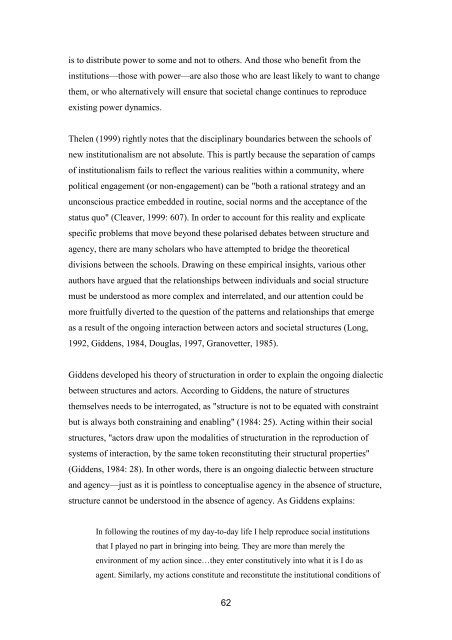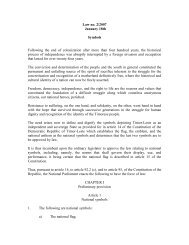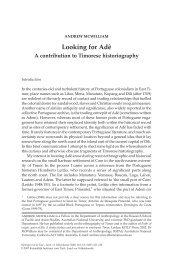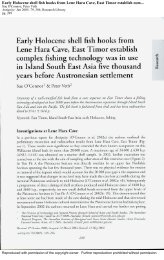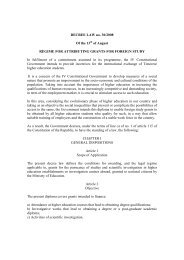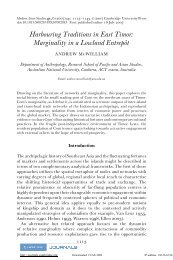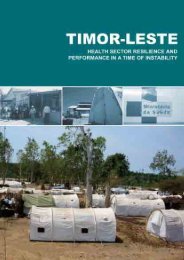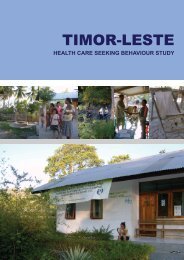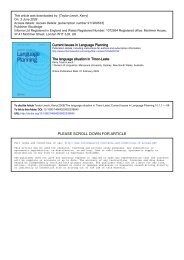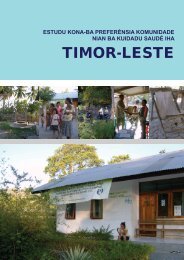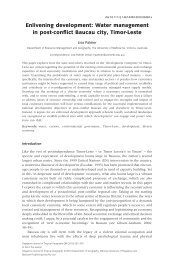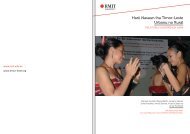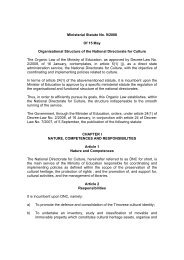Local Governance in Timor-Leste - Secretaria de Estado da Arte e ...
Local Governance in Timor-Leste - Secretaria de Estado da Arte e ...
Local Governance in Timor-Leste - Secretaria de Estado da Arte e ...
- No tags were found...
You also want an ePaper? Increase the reach of your titles
YUMPU automatically turns print PDFs into web optimized ePapers that Google loves.
is to distribute power to some and not to others. And those who benefit from the<strong>in</strong>stitutions—those with power—are also those who are least likely to want to changethem, or who alternatively will ensure that societal change cont<strong>in</strong>ues to reproduceexist<strong>in</strong>g power dynamics.Thelen (1999) rightly notes that the discipl<strong>in</strong>ary boun<strong>da</strong>ries between the schools ofnew <strong>in</strong>stitutionalism are not absolute. This is partly because the separation of campsof <strong>in</strong>stitutionalism fails to reflect the various realities with<strong>in</strong> a community, wherepolitical engagement (or non-engagement) can be "both a rational strategy and anunconscious practice embed<strong>de</strong>d <strong>in</strong> rout<strong>in</strong>e, social norms and the acceptance of thestatus quo" (Cleaver, 1999: 607). In or<strong>de</strong>r to account for this reality and explicatespecific problems that move beyond these polarised <strong>de</strong>bates between structure an<strong>da</strong>gency, there are many scholars who have attempted to bridge the theoreticaldivisions between the schools. Draw<strong>in</strong>g on these empirical <strong>in</strong>sights, various otherauthors have argued that the relationships between <strong>in</strong>dividuals and social structuremust be un<strong>de</strong>rstood as more complex and <strong>in</strong>terrelated, and our attention could bemore fruitfully diverted to the question of the patterns and relationships that emergeas a result of the ongo<strong>in</strong>g <strong>in</strong>teraction between actors and societal structures (Long,1992, Gid<strong>de</strong>ns, 1984, Douglas, 1997, Granovetter, 1985).Gid<strong>de</strong>ns <strong>de</strong>veloped his theory of structuration <strong>in</strong> or<strong>de</strong>r to expla<strong>in</strong> the ongo<strong>in</strong>g dialecticbetween structures and actors. Accord<strong>in</strong>g to Gid<strong>de</strong>ns, the nature of structuresthemselves needs to be <strong>in</strong>terrogated, as "structure is not to be equated with constra<strong>in</strong>tbut is always both constra<strong>in</strong><strong>in</strong>g and enabl<strong>in</strong>g" (1984: 25). Act<strong>in</strong>g with<strong>in</strong> their socialstructures, "actors draw upon the mo<strong>da</strong>lities of structuration <strong>in</strong> the reproduction ofsystems of <strong>in</strong>teraction, by the same token reconstitut<strong>in</strong>g their structural properties"(Gid<strong>de</strong>ns, 1984: 28). In other words, there is an ongo<strong>in</strong>g dialectic between structureand agency—just as it is po<strong>in</strong>tless to conceptualise agency <strong>in</strong> the absence of structure,structure cannot be un<strong>de</strong>rstood <strong>in</strong> the absence of agency. As Gid<strong>de</strong>ns expla<strong>in</strong>s:In follow<strong>in</strong>g the rout<strong>in</strong>es of my <strong>da</strong>y-to-<strong>da</strong>y life I help reproduce social <strong>in</strong>stitutionsthat I played no part <strong>in</strong> br<strong>in</strong>g<strong>in</strong>g <strong>in</strong>to be<strong>in</strong>g. They are more than merely theenvironment of my action s<strong>in</strong>ce…they enter constitutively <strong>in</strong>to what it is I do asagent. Similarly, my actions constitute and reconstitute the <strong>in</strong>stitutional conditions of62


